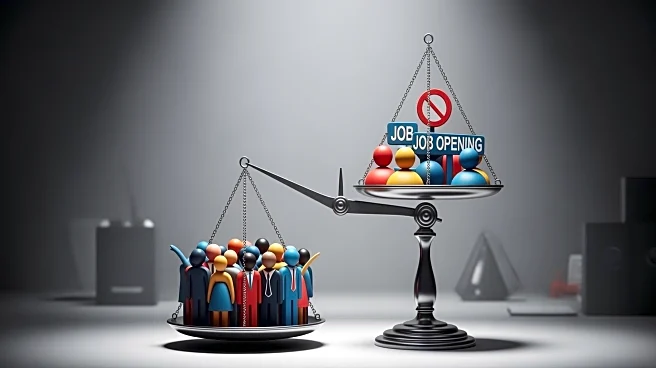What's Happening?
The Bureau of Labor Statistics has released its latest JOLTS report, revealing that the ratio of job vacancies to unemployed workers fell below 1 to 0.99 in July, marking the first time since April 2021 that there are more unemployed Americans than available
jobs. This shift is attributed to a decline in job openings rather than an increase in layoffs, as noted by Indeed economist Allison Shrivastava. The report indicates that job openings totaled 7.18 million for the month, which is below the 7.38 million expected by economists and the 7.36 million vacancies recorded in June. The data has influenced investor expectations, with a higher probability of an interest rate cut by the Federal Reserve in September. Despite the slowdown, economists like Tuan Nguyen from RSM suggest that the labor market is not signaling an imminent recession, as conditions appear close to the long-term, non-inflationary level targeted by the Fed.
Why It's Important?
This development is significant as it highlights a cooling labor market, which could have implications for economic policy and interest rates. The decrease in job openings suggests challenges for unemployed individuals trying to reenter the workforce, potentially affecting consumer spending and economic growth. The labor force participation rate has also declined, influenced by demographic changes and immigration policies from the Trump administration. The shift in labor market dynamics could lead to adjustments in monetary policy, with the Federal Reserve considering interest rate cuts to stimulate economic activity. The situation presents a mixed outlook, with potential benefits for employed workers due to reduced competition but challenges for those seeking employment.
What's Next?
The upcoming August jobs report, scheduled for release on Friday, will be crucial in determining the Federal Reserve's next steps regarding interest rates. A strong report could justify maintaining current rates, while weaker data might prompt a rate cut to support the labor market. Economists and policymakers will closely monitor labor market indicators to assess the broader economic impact and adjust strategies accordingly. The evolving labor market conditions may also prompt discussions on immigration policies and workforce development initiatives to address labor supply issues.
Beyond the Headlines
The current labor market situation raises questions about the long-term implications of demographic shifts and immigration policies on workforce availability. As the U.S. population ages, the labor force participation rate may continue to decline, necessitating policy interventions to sustain economic growth. Additionally, the balance between job openings and unemployment could influence wage dynamics and job security, impacting social and economic stability. The interplay between labor market trends and monetary policy will be a focal point for economists and policymakers in the coming months.













